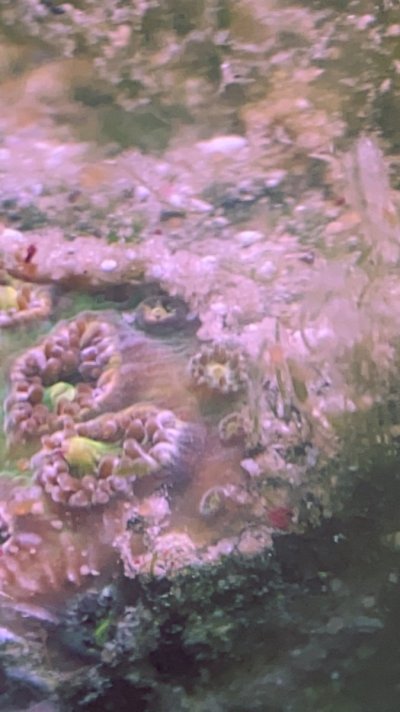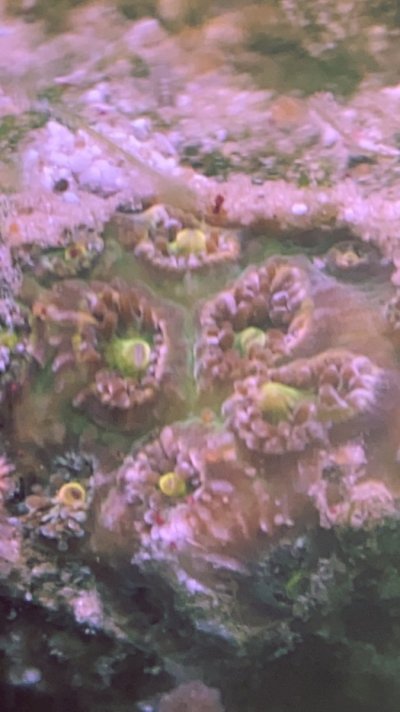Navigation
Install the app
How to install the app on iOS
Follow along with the video below to see how to install our site as a web app on your home screen.

Note: This feature currently requires accessing the site using the built-in Safari browser.
More options
You are using an out of date browser. It may not display this or other websites correctly.
You should upgrade or use an alternative browser.
You should upgrade or use an alternative browser.
LPS Hitchhiker ID
- Thread starter Rtaylor
- Start date
EeyoreIsMySpiritAnimal
Just another girl who likes fish
- Review score
- +0 /0 /-0
Partner Member 2023
Build Thread Contributor
- Joined
- May 14, 2019
- Messages
- 7,940
- Reaction score
- 11,218
- Review score
- +0 /0 /-0
- Location
- Spring, Texas
I don't know, but it's pretty! Maybe pectinia?
Last edited:
EeyoreIsMySpiritAnimal
Just another girl who likes fish
- Review score
- +0 /0 /-0
Partner Member 2023
Build Thread Contributor
- Joined
- May 14, 2019
- Messages
- 7,940
- Reaction score
- 11,218
- Review score
- +0 /0 /-0
- Location
- Spring, Texas
I'm terrible telling the Merulinidae corals apart.Thanks! But the skeleton doesn’t look right for that….maybe goniastrea?
@encrustingacro , any ideas?
Me too! From what I can tell the coralites are round with distinct walls for each coralite (definitely not favites). Each one is really tiny, just a mm or 2, if that info helps identify. Here are some images from when I first received it, the skeleton is more visible.I'm terrible telling the Merulinidae corals apart.
@encrustingacro , any ideas?
- Joined
- Aug 24, 2020
- Messages
- 1,204
- Reaction score
- 946
- Review score
- +0 /0 /-0
- Location
- Washington State
This one I can’t tell either. Maybe we can see what it looks like when it grows out.I'm terrible telling the Merulinidae corals apart.
@encrustingacro , any ideas?
Did the rock have the porites on it when you got it? If not, where was the rock from? If it was from the Caribbean/Atlantic, it is probably not a merulinid as the only merulinid that occurs there is orbicella, which looks different.Got this hitchhiker on the rock a porites frag was on. Wondering if someone could help with an ID? I can definitely see a stony skeleton. Favia maybe? Originally only had 3-4 eyes. Each ‘eye’ is tiny, like a mm or less. Thanks!View attachment 2821780View attachment 2821781View attachment 2821782View attachment 2821783View attachment 2821784View attachment 2821785
On second thought, if it has small corallites, it could be a plesiastrea, but I’m not sure. Could you show a picture of it with its tentacles out please?
Thanks! I’m not 100% sure, but I believe the origin was indo/pacific. I can try for a pic tomorrow.This one I can’t tell either. Maybe we can see what it looks like when it grows out.
Did the rock have the porites on it when you got it? If not, where was the rock from? If it was from the Caribbean/Atlantic, it is probably not a merulinid as the only merulinid that occurs there is orbicella, which looks different.
On second thought, if it has small corallites, it could be a plesiastrea, but I’m not sure. Could you show a picture of it with its tentacles out please?
It’s really small, so this was the best I could get. Thanks!This one I can’t tell either. Maybe we can see what it looks like when it grows out.
Did the rock have the porites on it when you got it? If not, where was the rock from? If it was from the Caribbean/Atlantic, it is probably not a merulinid as the only merulinid that occurs there is orbicella, which looks different.
On second thought, if it has small corallites, it could be a plesiastrea, but I’m not sure. Could you show a picture of it with its tentacles out please?


EeyoreIsMySpiritAnimal
Just another girl who likes fish
- Review score
- +0 /0 /-0
Partner Member 2023
Build Thread Contributor
- Joined
- May 14, 2019
- Messages
- 7,940
- Reaction score
- 11,218
- Review score
- +0 /0 /-0
- Location
- Spring, Texas
Do you think it's Mycedium? I found this pic and description that seem pretty close... (it's not the same coloration as yours, but otherwise seems to match)

Peacock Coral (Mycedium sp.) is hard coral of variable shape and color. It may be flat and fan-shaped or it may have irregular finger-like lobe growths. Color ranges from brown or gold to neon green, with new growth areas being lighter in color. These corals require high light and good conditions for optimum growth and are best kept in mature aquariums.
Mycedium corals are very similar to Echinophyllia and Oxypora corals. The edges of the colony in Oxypora corals are much more ridged than the smoother, rolls appearance of the edges of Mycedium colonies. The ridges radiating from the center of the colony are also more serrated and tooth-like in Echinophyllia corals than in Mycedium. The raised corallites in Mycedium are also inclined towards the perimeter of the colony.
Peacock Coral (Mycedium sp.) is hard coral of variable shape and color. It may be flat and fan-shaped or it may have irregular finger-like lobe growths. Color ranges from brown or gold to neon green, with new growth areas being lighter in color. These corals require high light and good conditions for optimum growth and are best kept in mature aquariums.
Mycedium corals are very similar to Echinophyllia and Oxypora corals. The edges of the colony in Oxypora corals are much more ridged than the smoother, rolls appearance of the edges of Mycedium colonies. The ridges radiating from the center of the colony are also more serrated and tooth-like in Echinophyllia corals than in Mycedium. The raised corallites in Mycedium are also inclined towards the perimeter of the colony.
Thanks! Could be, that’s the problem, half the pics I look at, look like maybe….. I’ll look into mycedium more and see if I can find anything that rules it in or out.Do you think it's Mycedium? I found this pic and description that seem pretty close... (it's not the same coloration as yours, but otherwise seems to match)
View attachment 2822318
Peacock Coral (Mycedium sp.) is hard coral of variable shape and color. It may be flat and fan-shaped or it may have irregular finger-like lobe growths. Color ranges from brown or gold to neon green, with new growth areas being lighter in color. These corals require high light and good conditions for optimum growth and are best kept in mature aquariums.
Mycedium corals are very similar to Echinophyllia and Oxypora corals. The edges of the colony in Oxypora corals are much more ridged than the smoother, rolls appearance of the edges of Mycedium colonies. The ridges radiating from the center of the colony are also more serrated and tooth-like in Echinophyllia corals than in Mycedium. The raised corallites in Mycedium are also inclined towards the perimeter of the colony.
Edit:
I think I can rule out mycedium as it doesn’t look like the eyes all face out. But maybe echinophyllia (chalice)? Same family as mycedium…….
Last edited:
I think plesiastrea can be eliminated as it doesn’t have the prominent paliform lobe that would indicate.

Do you think it could be: Oulastrea crispate?
This pic from the link below really looks a lot like it….and it had small corallites….Zebra corals (Ouslastrea crispata) on the Shores of Singapore
Fact sheet with photos on flora and fauna of Singapore's intertidal shores
www.wildsingapore.com
Last edited:
- Joined
- Aug 24, 2020
- Messages
- 1,204
- Reaction score
- 946
- Review score
- +0 /0 /-0
- Location
- Washington State
Judging from the skeleton, I don’t think it would be a mycedium, or any sort of chalice.Do you think it's Mycedium? I found this pic and description that seem pretty close... (it's not the same coloration as yours, but otherwise seems to match)
View attachment 2822318
Peacock Coral (Mycedium sp.) is hard coral of variable shape and color. It may be flat and fan-shaped or it may have irregular finger-like lobe growths. Color ranges from brown or gold to neon green, with new growth areas being lighter in color. These corals require high light and good conditions for optimum growth and are best kept in mature aquariums.
Mycedium corals are very similar to Echinophyllia and Oxypora corals. The edges of the colony in Oxypora corals are much more ridged than the smoother, rolls appearance of the edges of Mycedium colonies. The ridges radiating from the center of the colony are also more serrated and tooth-like in Echinophyllia corals than in Mycedium. The raised corallites in Mycedium are also inclined towards the perimeter of the colony.
Thanks for the photos. Judging from the open polyps, I don’t think it would be a plesiastrea.It’s really small, so this was the best I could get. Thanks!
View attachment 2822272View attachment 2822273View attachment 2822274View attachment 2822275View attachment 2822276View attachment 2822277View attachment 2822278View attachment 2822279View attachment 2822280View attachment 2822281View attachment 2822282View attachment 2822283View attachment 2822284View attachment 2822285View attachment 2822286View attachment 2822287View attachment 2822289View attachment 2822290 View attachment 2822288 View attachment 2822291
Looking from the skeleton, it could be, but looking from the flesh, it doesn’t look like it. Oulastrea usually isn’t colorful, and you can usually see the skeleton through its flesh. Also, oulastrea has clear tentacles when feeding, while your coral has opaque tentacles.I think plesiastrea can be eliminated as it doesn’t have the prominent paliform lobe that would indicate.
Do you think it could be: Oulastrea crispate?
This pic from the link below really looks a lot like it….and it had small corallites….View attachment 2822355
Zebra corals (Ouslastrea crispata) on the Shores of Singapore
Fact sheet with photos on flora and fauna of Singapore's intertidal shoreswww.wildsingapore.com
I asked a coral taxonomist, and he said that it’s merulinidae sp.
Thanks for your help!Judging from the skeleton, I don’t think it would be a mycedium, or any sort of chalice.
Thanks for the photos. Judging from the open polyps, I don’t think it would be a plesiastrea.
Looking from the skeleton, it could be, but looking from the flesh, it doesn’t look like it. Oulastrea usually isn’t colorful, and you can usually see the skeleton through its flesh. Also, oulastrea has clear tentacles when feeding, while your coral has opaque tentacles.
I asked a coral taxonomist, and he said that it’s merulinidae sp.
EeyoreIsMySpiritAnimal
Just another girl who likes fish
- Review score
- +0 /0 /-0
Partner Member 2023
Build Thread Contributor
- Joined
- May 14, 2019
- Messages
- 7,940
- Reaction score
- 11,218
- Review score
- +0 /0 /-0
- Location
- Spring, Texas
Well, that includes most of the possibilities suggested, lolI asked a coral taxonomist, and he said that it’s merulinidae sp.
- Joined
- Aug 24, 2020
- Messages
- 1,204
- Reaction score
- 946
- Review score
- +0 /0 /-0
- Location
- Washington State
True, but it excludes oulastrea and plesiastrea.Well, that includes most of the possibilities suggested, lol
Similar threads
- Replies
- 10
- Views
- 329
- Replies
- 8
- Views
- 214













